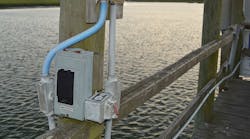How well do you know the Code? Think you can spot violations the original installer either ignored or couldn’t identify? Here’s your chance to moonlight as an electrical inspector and second-guess someone else’s work from the safety of your living room or office. Can you identify the specific Code violation(s) in this photo? Note: Submitted comments must include specific references from the 2014 NEC.
Hint: Papa Smurf would definitely disapprove.
October Winners
Thanks to Warren Tinker for sharing this photo with us. He found this when a homeowner called and asked him to install some missing covers on a panel and make some other repairs.
Our winners this month were Kevin Singleton, an apprentice electrician with Highlights Electrical in Houston, and John Lloyd, president of John A. Lloyd & Associates in Durham, N.C. Both men knew the main lugs for this panel are not permitted to have wires doubled-up inside them.
Section 110.14(A) plainly states that terminals designed for more than one conductor must be identified as such. These terminals are not designed that way, and they look very overcrowded and strained. Another problem is the mixing of copper and aluminum wires in those same terminals. Mixing dissimilar metals, such as copper with aluminum, copper with copper-clad aluminum, or aluminum and copper-clad aluminum in the same terminal, is generally not permitted by Sec. 110.14. Specially designed devices identified for the purpose must be used when mixing dissimilar metals in the same terminal. Mixing dissimilar metals in connectors can result in loose connections and overheating due to the different expansion and contraction rates of the different metals.






